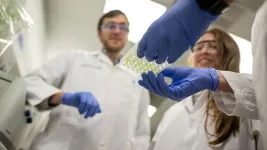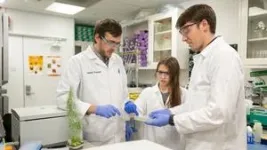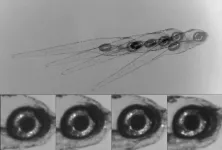(Press-News.org) To stay healthy, plants balance the energy they put into growing with the amount they use to defend against harmful bacteria. The mechanisms behind this equilibrium have largely remained mysterious.
Now, engineers at Princeton have found an answer in an unexpected place: the harmless, or sometimes beneficial, bacteria that cluster around plants’ roots.
In an article published Dec. 24 in the journal Cell Reports, researchers showed that some types of soil bacteria can influence a plant’s balance of growth and defense. The bacteria produce an enzyme that can lower a plant’s immune activity and allow its roots to grow longer than they would otherwise.
“This is trying to get at a really big biological question where there are not good answers — about how microbiomes interface with host immune systems,” said senior study author Jonathan Conway, an assistant professor of chemical and biological engineering. “It’s a small step in the direction of trying to understand how microbes live on hosts — either plants or humans or other animals — all the time and don’t activate our immune responses constantly.”
To search for immune-balancing bacteria, Conway’s team turned to plants that were engineered to have heightened immune responses to a protein that makes up the threadlike appendages, called flagella, that allow bacteria to swim. The protein that makes up flagella, called flagellin, is a potent trigger of immune responses in hosts from plants to humans.
The researchers grew seedlings of Arabidopsis — a small plant in the mustard family that’s commonly used in plant research — from a line that was engineered to produce high levels of flagellin-sensing immune receptor in its roots. When grown on plates containing the piece of flagellin that activates this receptor, the seedlings’ roots are short and stubby, since their energy is directed toward immunity more than growth.
The experiment involved growing the seedlings on plates with flagellin as well as with 165 different bacterial species isolated from the roots of soil-grown Arabidopsis. 68 of these isolates, or 41%, suppressed the stunted growth response by tamping down the plants’ immunity and allowing their roots to grow longer.
One of the bacterial species that allowed the roots to grow the best was Dyella japonica. Previous work had shown that that this species’ immune-modulating activity was dependent on a bacterial secretion system — a protein complex that can move substances out of bacterial cells and into the environment, including inside plant cells or the spaces between plant cells.
A scan of D. japonica’s genome revealed a gene encoding a secreted enzyme called a subtilase, with the potential ability to chop flagellin into small pieces and prevent it from activating the immune response.
The team used both genetic and biochemical methods to demonstrate that the subtilase enzyme was indeed capable of degrading the specific segment of flagellin that triggers the immune response. The degradation was sufficient to tamp down the immune response and allow for increased growth in Arabidopsis seedlings.
The researchers ran into some snags when trying to purify the subtilase enzyme, said Samuel Eastman, a co-first author of the paper and a postdoctoral research associate in Conway’s lab. Obtaining pure protein is essential for definitively demonstrating an enzyme’s function in a test tube.
In 2023, Eastman presented a poster on the project at a conference in Providence, Rhode Island, and was approached by Todd Naumann, a chemist at the USDA’s Agricultural Research Service in Peoria, Illinois. Naumann said his experience suggested the enzyme could be purified from yeast cells, rather than bacteria.
Within a couple of months, Naumann had purified the protein and shipped it to Princeton. “Now we can do chemistry with it, and we can actually look at this in vitro,” said Eastman. “We’re able to achieve a level of investigation into this protein that wouldn't have been possible without that collaboration.”
Naumann is a co-author on the paper, along with eight other Princeton researchers in addition to Eastman and Conway. The process of screening and verifying 165 bacterial isolates was a lengthy team effort, and six undergraduates were integral to this and other aspects of the work, said Conway. Britley Jones, a member of Princeton’s Class of 2023, played a key role in screening the bacterial collection as part of her senior thesis.
Eastman shares lead authorship of the paper with postdoctoral research associate Ting Jiang and Kaeli Ficco, a 2024 Princeton graduate who is now a Ph.D. student at Cornell University. As part of her thesis, Ficco helped engineer mutant bacterial strains that demonstrated a genetic requirement for the subtilase gene in immune suppression and developed some of the experimental methods herself.
“I really liked how discovery-based the project was,” said Ficco. “That definitely influenced my trajectory after Princeton.” Now, she is beginning studies on the regulation of immunity by the human microbiome.
Beyond analyzing the specific enzyme produced by D. japonica, the team found that similar genes are found in many common soil bacteria, and their assays showed that dozens of bacterial isolates could suppress flagellin-induced immunity.
Now, they would like to better understand why these enzymes may be advantageous to both bacteria and their plant hosts. One hypothesis is that chopping up the flagella of pathogens prevents them from moving and invading a plant’s roots.
“So, in that way it could be suppressing pathogens as well as the plant immune system,” said Eastman. An alternative hypothesis is that these enzymes are “suppressing the immune system so a pathogen could maybe go undetected and cause more disease than it would otherwise.”
The latter scenario would be problematic in harnessing this phenomenon to improve growth in agricultural settings, because it could make plants more vulnerable to disease. So, more study is needed, said Eastman.
“We don’t want to compromise the immune system, but we also want plants to save that immune response for when it matters,” he said. “We want them to keep calm and keep growing.”
END
These bacteria perform a trick that could keep plants healthy
2025-01-02
ELSE PRESS RELEASES FROM THIS DATE:
Expanding the agenda for more just genomics
2025-01-02
Genomics is being integrated into biomedical research, medicine, and public health at a rapid pace, but the capacities necessary to ensure the fair, global distribution of benefits are lagging. A new special report outlines opportunities to enhance justice in genomics, toward a world in which genomic medicine promotes health equity, protects privacy, and respects the rights and values of individuals and communities.
The report, “Envisioning a More Just Genomics,” is a collaboration between ...
Detecting disease with only a single molecule
2025-01-02
UC Riverside scientists have developed a nanopore-based tool that could help diagnose illnesses much faster and with greater precision than current tests allow, by capturing signals from individual molecules.
Since the molecules scientists want to detect -- generally certain DNA or protein molecules -- are roughly one-billionth of a meter wide, the electrical signals they produce are very small and require specialized detection instruments.
“Right now, you need millions of molecules to detect ...
Robert McKeown recognized for a half century of distinguished service
2025-01-02
NEWPORT NEWS, VA – For nearly half a century, Robert D. “Bob” McKeown has probed nuclear particles and educated rising generations of physicists. Now, the former deputy director for science at the U.S. Department of Energy’s Thomas Jefferson National Accelerator Facility is being honored for his outstanding career contributions with the 2024 American Physical Society’s Division of Nuclear Physics (DNP) Distinguished Service Award.
McKeown is recognized for his work in experimental physics and his extensive leadership in the broader ...
University of Maryland awarded $7.8 million to revolutionize renewable energy for ocean monitoring devices
2025-01-02
University of Maryland researcher Stephanie Lansing received a Phase 1 $7.8M award from Defense Advanced Research Projects Agency (DARPA) to develop and test a biologically fueled energy source to power research and sensing devices throughout the world’s oceans.
There is a vast array of ocean sensing devices that provide critical information for understanding marine environments, monitoring climate change and maintaining national security. Many of these sensors are currently powered by long underwater cables or lithium-ion batteries.
Lansing is leading a large, collaborative effort that will overcome the need for batteries and ship-based or shore-based ...
Update: T cells may offer some protection in an H5N1 ‘spillover’ scenario
2025-01-02
Update: This LJI study was previously shared on bioRxiv in September 2024. Since then, health officials have reported a rise in H5N1 “bird flu” infections in humans, including the first severe H5N1 human case requiring hospitalization. Officials have also reported increased cases in feline species, including an outbreak among big cats at a wildlife sanctuary. In California, the recent spread of H5N1 to dairy herds in Southern California prompted Gov. Gavin Newsom to declare a “State of Emergency” on Dec. 18, 2024.
LA JOLLA, CA—New research led by scientists at La Jolla Institute for Immunology (LJI) ...
Newborn brain circuit stabilizes gaze
2025-01-02
An ancient brain circuit, which enables the eyes to reflexively rotate up as the body tilts down, tunes itself early in life as an animal develops, a new study finds.
Led by researchers at NYU Grossman School of Medicine, the study revolves around how vertebrates, which includes humans and animals spanning evolution from primitive fish to mammals, stabilize their gaze as they move. To do so they use a brain circuit that turns any shifts in orientation sensed by the balance (vestibular) system in their ears into an instant counter-movement by their eyes.
Called ...
Bats surf storm fronts during continental migration
2025-01-02
Birds are the undisputed champions of epic travel—but they are not the only long-haul fliers. A handful of bats are known to travel thousands of kilometers in continental migrations across North America, Europe, and Africa. The behavior is rare and difficult to observe, which is why long-distance bat migration has remained an enigma. Now, scientists from the Max Planck Institute of Animal Behavior (MPI-AB) have studied 71 common noctule bats on their spring migration across the European continent, providing a leap in understanding this mysterious behavior. Ultra-lightweight, intelligent sensors attached ...
Canadian forests are more prone to severe wildfires in recent decades
2025-01-02
Climate change is driving more intense wildfires in Canada, according to a new modeling study, with fuel aridity and rising temperatures amplifying burn severity, particularly over the last several decades. The findings underscore the growing impact of climate change on wildfire behavior, with the most severe effects concentrated in Canada’s northern forests. Fueled by ongoing climate change, Canada – one of the most forested and fire-prone regions in the Northern Hemisphere – is grappling with increasingly severe and prolonged wildfire seasons. ...
Secrets of migratory bats: They “surf” storm front winds to save energy
2025-01-02
A species of migrating bat “surfs” the warm winds of incoming storm fronts to conserve energy, according to a study that used tags to track the tiny animals on their long journeys across central Europe. The findings offer new insights into how weather, physiology, and environmental factors shape bats’ seasonal migration patterns. While bird migration is well-documented and studied, this is not the case for seasonal migration of bats – particularly the few long-distance, migratory species. These nocturnal travelers face substantial challenges, ...
Early life “luck” among competitive male mice leads to competitive advantage overall
2025-01-02
Early life "luck" plays a pivotal role in shaping individuality and success, particularly for males, according to a new study in mice. In male animals, competitive social dynamics amplified small initial differences into lifelong disparities in fitness. The findings highlight parallels between biological competition and societal inequalities and they demonstrate how chance events can drive divergent outcomes even among genetically identical individuals. Contingency (colloquially, “luck”) refers to the role of chance in shaping outcomes. It is a critical factor in both biological and social sciences, ...





